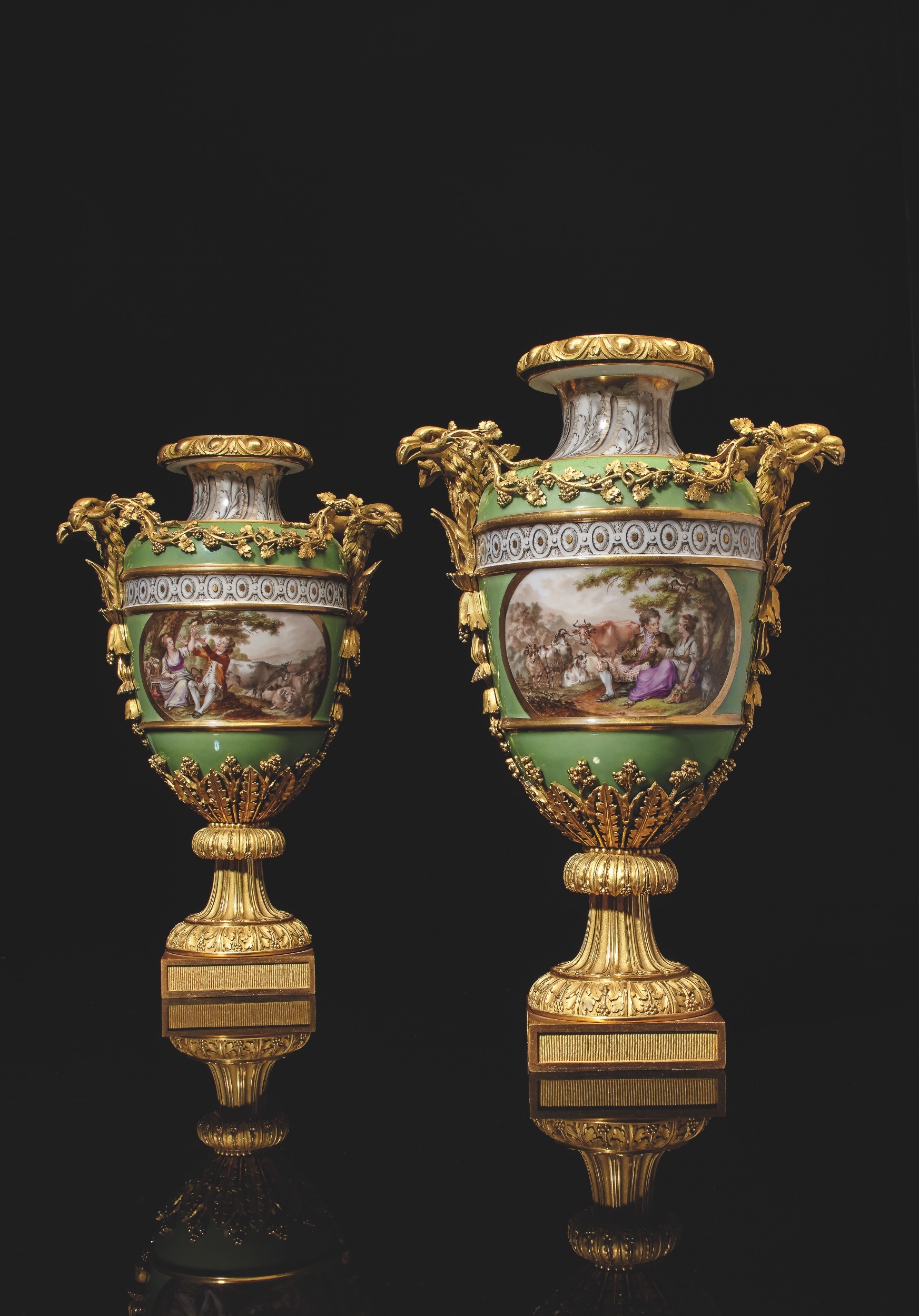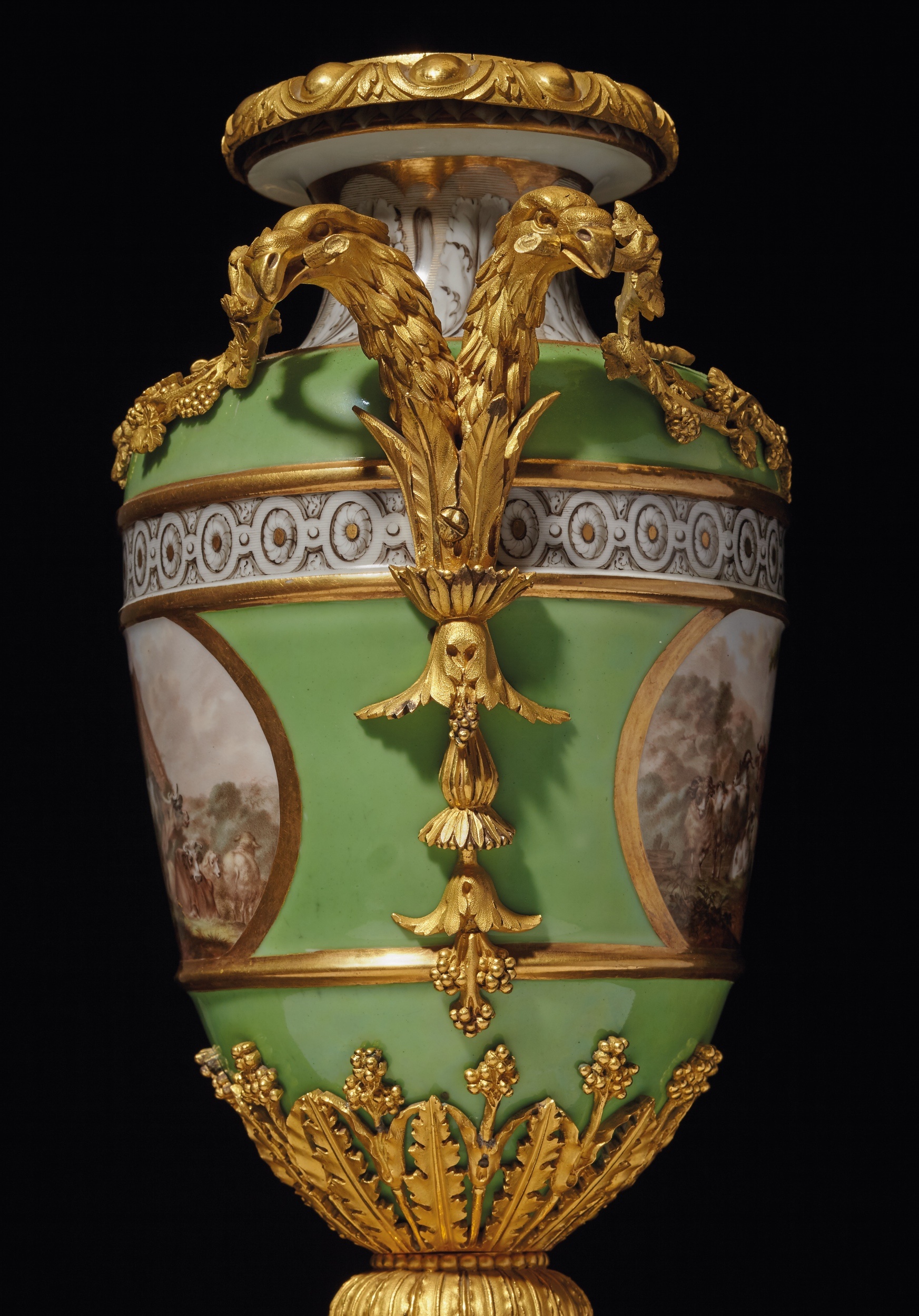

1785


Each shield-shaped vase painted with grisaille leaves alternate with faux flutes, flanked by double eagle head handles issuing fruiting grape vine and terminating in variant pendant leaves, finely painted front and back with pastoral views of amorous couples before cows, sheep and goats probably after drawings by Boucher, on a conforming fluted ormolu base moulded with stiff leaf tips and acanthus, one stamped 'E 83'
The Palais de l’Elysée
With Vandermeersch, Paris, before 1993.
Anonymous sale; Picard, Maison de la Chimie, Paris, 7 March 1993, lot 141.
Segoura, Paris.
Private Collection America
The Élysée Palace was built for the Comte d’Evreux in 1722. Upon his death in 1753 it was bought by Louis XV for his mistress, the Marquise de Pompadour. When she died in 1764, the Hôtel d’Evreux, as it was known, was bought by the fabulously wealthy banker Nicolas Beaujon. When the banker Nicholas Beaujean died in 1786, Louis XVI decided to buy it at a cost of 1,110,000 livres with the idea of using it for visiting ambassadors as his grandfather, Louis XV had intended. In the end, his cousin, Bathilde d'Orleans prevailed upon the King to sell it to her for 600,000 livres. Bathilde was the daughter of the Duc d'Orléans and sister of the Duc de Chartres. In 1770, at the age of 19, she married the very young (14) Duc de Bourbon, the son of the fabulously wealthy Prince de Condé. The doctors decided to keep them separate which enraged the young husband. he set about releasing her from her convent where she was living. However, not six months afterwards he never looked at her again. His father, the Prince, took her to live with him at Chantilly and built another Château for her. On the 2nd. of June 1772, the young Duc d'Enghien was born. Not only did her father-in-law build her a Château but he also created a
wonderful Sylvan hamlet complete with village houses, shepherds and a river with bridges. Unfortunately Bathilde fell foul of the unforgiving nature of the Prince when she composed a barely disguised allegory which sent him into a terrifying rage. The Prince along with his son (also mentioned in Bathilde's ditty), who were both described
as 'excessively vindictive' would not pardon her. The result was her permanent exile from Chantilly and the loss of her son. She went to live with her father who was a man of affection and indulgence towards his daughter. She took lovers, among whom was Alexandre de Roquefeuille. This liason produced a daughter after the young naval officer was drowned at Dunkerque. The little girl Victorine-Adélaïde, was passed off as Bathilde's Goddaughter. A few months later, her father died leaving her several million livres. Her husband attempted a reconciliation but fearing the loss of her daughter, she refused to return to him. In July 1785 moved into the Hôtel de Beaujon (formerly Evreux and then de Pompadour).
She was 37 years old and decided to relive her happy times at Chantilly. Both Madame de Pompadour and Nicolas Beajon, the banker, had added hugely to the park. Bathilde, long before Marie-Antoinette built the Petit Hameau close to the Petit Trianon. At huge expense had a pretend village complete with thatched buildings, luxuriously furnished on the interiors, a dairy and a mill whose blades were turned by an artifiical cascade, a navigable stream with bridges and all complimented with singing shepherds. It is possible that these vases were made for one of these buildings or, indeed, for the interiors of the Hôtel which she renamed the Élysée. As befitted a Princess of the blood royal, she fitted it out with silks from Lyons and the finest furniture. However, she lived with few servants. As a separated wife, through no fault of her own, she could not attend Court. She was a highly talented musician and painter.
The marriage was not a good one and the couple separated permanently in 1780. Unable to live at Versailles because of her marital state, according to the conventions of the court, she lived at Chantilly. Before her marriage she was known as Madamoiselle. From 1787 she lived in Paris. It was she that renamed the former Hôtel d’Evreux, the Élysée in that year. The Champs Élysées was, in those days a huge open space. Although Beaujon had created gardens in the English manner, the Duchesse created an Hameau de Chantilly which she named after her father-in-law, the Prince de Condé’s Château de Chantilly. Like her brother, Philippe de France, the Duc d’Orléans, she was descended directly from Louis XIV’s brother, Philippe. As such she was a Princess of the blood royal, and called her Serene Highness. Her husband’s family descended from Henri III and became the Princes de Condé.
| Dimensions | CM | Inches |
|---|---|---|
| Width: | 22 | 8.5 |
| Depth: | 13 | 5 |
| Height: | 38 | 15 |